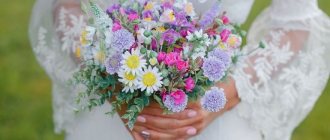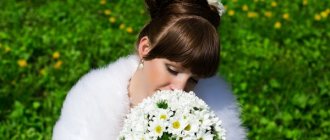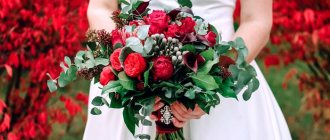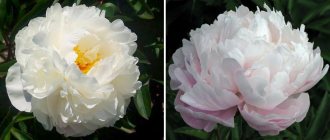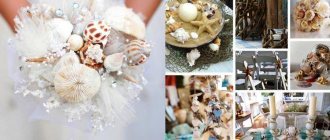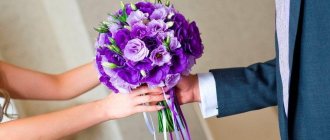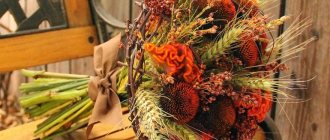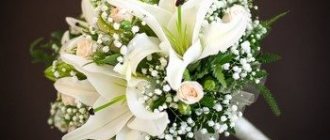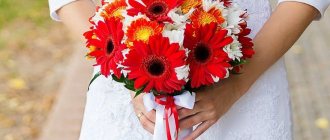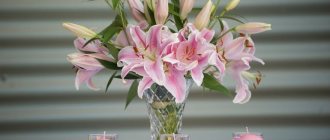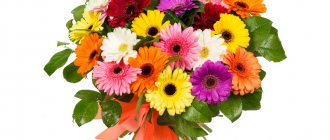Chrysanthemum is one of the best flowers for making bouquets: it retains freshness for a long time, has a light bitter aroma and goes well with a wide variety of flowers. If you want to create an original combined bouquet, it is important to take into account the shade and size of the buds, the general mood of the composition and design features. Compositions of bouquets of spray chrysanthemums look very beautiful.
Before moving on to describing several floral ideas, it is worth understanding what kind of chrysanthemums there are.
- Small bush and large-flowered varieties - simple, double and semi-double - are grown on plantations and in greenhouses.
- Breeders have developed summer, autumn and winter (greenhouse) varieties, and the shape of the inflorescences can be spherical, radiant, or feather-shaped - to suit every taste.
Chrysanthemum bouquets can be given to both women and men. It is only important to choose the appropriate packaging and color combinations. Which? It’s worth talking about this in more detail.
Chrysanthemum in floristry
In the autumn, when most flowering crops are already withering and preparing to rest, chrysanthemum is just beginning to bloom. The richness of colors and variety of buds attracts the attention of florists to this plant.
Chrysanthemum is widely used not only as one of the main elements of landscape design, but has also found its application in floristry. Floral arrangements, the main element of which are small bush or single large-flowered chrysanthemums, are a modest gift, but at the same time full of inner dignity.
This bouquet is suitable for various occasions, from a romantic date to a formal event. With the help of this amazingly beautiful and colorful flower you can express your respect, respect, recognition, sympathy, infatuation or even passionate love.
Tulips and daffodils
Symbols of spring are tulips and daffodils. Despite their poor tolerance to other flowers, they have every chance of standing for a long time in one vase. Since they are from the same bulbous family, the mucus they secrete into the water will not affect the durability. They have a universal meaning and are suitable for any occasion.
What colors does it go with?
The uniqueness of the chrysanthemum lies in its ability to combine with almost any other flower. So, according to the opinions of experienced florists, combinations with iris, daffodil and branches of greenery will look interesting. A bouquet containing lilies or gerberas looks no less original and stylish.
Making a “chamomile” bouquet with your own hands at a time when the daisies have long since faded will not be difficult - just take a few branches of small white bush chrysanthemums with characteristic yellow-green centers.
Roses
The rose, which due to its unique beauty and sophistication is considered the queen of flowers, will look harmonious in a flower arrangement with small autumn chrysanthemums. Depending on the chosen color and design style, such a bouquet can be presented to your beloved girl, friend or colleague.
The combination of white, milky and light pink buds is often used by florists to create wedding flower arrangements. But it is better to avoid a combination of red roses and white terry chrysanthemums - such a bouquet looks too pretentious and pretentious.
Alstroemeria
Chrysanthemums look harmonious with alstroemeria, which is distinguished by its richness and variety of colors, as well as the absence of a pronounced aroma. Small green leaves look very tender and touching.
Chrysanthemums with alstroemeria, packed in craft paper, will be an ideal gift for a girl with character traits such as cheerfulness, activity, initiative and energy.
Gerberas
The variety of colors of gerberas and the colorfulness of autumn chrysanthemums are interestingly combined in one bouquet. This stylish floral arrangement, decorated in a basket or hat box, is suitable for congratulating the hero of the day or a colleague.
However, if you give preference to the delicate shades of the buds of the flowers used, you will get a very original and exquisite wedding bouquet.
Tulips
According to experts in the field of floristry, delicate floral arrangements are currently very popular, which are often given to young girls or used as a bridal bouquet. Thus, the combination of sprigs of bush chrysanthemum, delicate matthiola and touching tulip in pastel shades personify the love and sympathy of the giver.
Bright shades (yellow, orange, hot pink, red, burgundy, crimson and even blue) are more suitable for energetic and cheerful people.
Carnations
White carnations with sprigs of soft pink chrysanthemum and lilac eustoma are used by florists to create wedding bouquets. Since ancient times, carnations have symbolized the strength of marriage bonds and emphasized the innocence and touching image of the newlywed.
Plant compatibility at the biological level
When collecting a bouquet, you also need to understand that not all plants “get along” with each other. Some flowers will openly conflict on a chemical level, accelerating wilting and spoiling the appearance of the buds. Cut flowers release certain substances. For example, fresh, spring daffodils release a slimy, thick sap that gradually turns into a jelly-like mass and seals the vessels of neighboring plants. You can put these primroses in a vase with other flowers no earlier than every other day. During this time, the juice will be released completely, after which the water should be changed. Cut orchids, carnations, and lilies of the valley do not combine well with other flowers. Lilies of the valley have a particularly detrimental effect on plants with delicate stems: forget-me-nots, crocuses, tulips, bells, violets.
The aggressive lily significantly accelerates the drooping of the delicate petals of other flowers. You cannot put daisies, poppies, or peonies in a vase with it. And even popular roses cannot boast of being harmless. They negatively affect carnations and callas. Moreover, even different types of roses, for example, tea and hybrid, can be incompatible. The following plants can be used to extend the period of flowers remaining in a bouquet:
- fragrant geranium (recommended to add to peonies);
- branches of thuja, juniper, cypress (combined with nasturtiums and aquilegia);
- woodruff and jasmine (look great with lilies of the valley).
The juice of these plants has bactericidal properties, disinfects water and, therefore, prevents stem rotting. And calceolarias placed in the same vase together with cyclamens will enhance each other’s colors.
Monobouquet
Thanks to the successful work of domestic and foreign breeders, several tens of thousands of varieties of chrysanthemums have been bred, which differ in stem height, bud diameter and, of course, color. Such a variety of choices opens up unlimited possibilities for beginners and professional florists when composing flower arrangements involving this decorative crop.
Small double flowers or large buds, monochrome, contrasting or multi-colored, long or short branches - there are many options for designing mono-bouquets of chrysanthemums.
Symbolic meaning
It is nice to receive even a simple bouquet of chrysanthemum roses as a gift, as it symbolizes joy, prosperity and longevity. If you want to give a flower tandem a special meaning, you need to carefully select the shades of the buds. Often, royal beauties themselves have one meaning, but together they speak of something else.
The following table will reveal the nuances of the subtle language of floral symbolism.
| Roses | Chrysanthemums | In composition |
| Red - passion, strong love, admiration for the object of feelings. | Yellow - in the east means success, wisdom, wealth, health. | An offer of marriage. |
| White – innocence, purity of feelings, fidelity. | Devotion, sincerity of intentions, impeccability. | They symbolize the best feminine qualities of the bride. |
| Pink – tenderness, coquetry, easy falling in love, romance, freshness and youth | Lilac, lilac, pale blue - sympathy, friendliness, desire to show care. | Gifted at the beginning of a relationship. Good for a first date. |
Options for wedding bouquets
A wedding bouquet of chrysanthemums is suitable for both a young bride and an adult, wise newlywed. This amazingly beautiful flower looks best in the form of a classic even bouquet or a hemisphere. An asymmetrical composition will have an attractive and original look.
Tender sprigs of greenery are suitable as decorative elements. However, if you like more sophisticated options, you can use embellished pins, pearls, crystal rhinestones and ribbons. In order for the bouquet to look decent, elegant and gentle, there should be little decor.
Roses and eustomas
Despite the fact that eustoma looks very much like a rose bud, it belongs to herbaceous plants of the Gentian family.
Pleasant and delicate in appearance, eustoma will last a long time in a vase and remain fresh. It can be given as a gift for any occasion, but it is not usually given to men. In combination with a rose it will become a tender declaration of love.
How to make it yourself
Many people mistakenly believe that only professional florists who know how to correctly select composition elements and appropriate packaging can assemble a beautiful bouquet. However, the semantic meaning of any bouquet is a reflection of the feelings of the giver. Your version may not be as beautiful and sophisticated, but its tenderness and sincerity can conquer and surprise any person.
Tools and materials
Let's try to make a bouquet of chrysanthemums with our own hands. First you need to decide on the shape and main components of the flower arrangement.
During the work you will need:
- flowers;
- sprigs of greenery;
- scissors and a sharp knife;
- thin wire;
- container for the base (sponge soaked in water, vase, flower pot);
- packaging materials (kraft paper, mesh, Korean matte film, basket, hat box, etc.);
- elements for decoration (butterflies, birds, small teddy bear, etc.).
Combination of shades in flower arrangements
The main thing in any bouquet is the color. They pay attention to it first of all, and then they look at the style, shape and design. A lot of literature is devoted to colorism, so we will note only the most important points.
What is Itten's color circle
Floristic color science is based on the theory of color combinations by Johannes Itten. He proposed a scheme that is shown in the figure. Triangle shades are basic: they cannot be created by mixing. Those located at the ends of the hexagon are the result of mixing the base ones to create the shades of the circle. Later the scheme was finalized, and each color was divided into tones.
Basic rules for working with the color wheel:
- Contrast
.
Florists use flowers of opposite shades. A striking example is the red-green New Year's compositions
made of scarlet roses and pine needles. - Similar palette
. A bouquet of flowers is collected, the buds of which are colored in shades adjacent to the circle, for example, red and orange. Neighboring colors are always perceived holistically and completely.
- Monochromatic bouquets
They are as simple as possible, but they create true masterpieces.
Florists use the same color, but in different saturations. Often, using this principle, plants are combined in designer ensembles and bouquets with a gradient
. - Polychromatic range
.
They combine many different shades from the circle, resulting in motley colorful mixes
.
Conventionally, florists divide shades into feminine and masculine. The first group includes almost the entire palette, in some cases even black and dark purple flowers are appropriate. Men's colors include strict colors: blue, muted red, green and gold.

